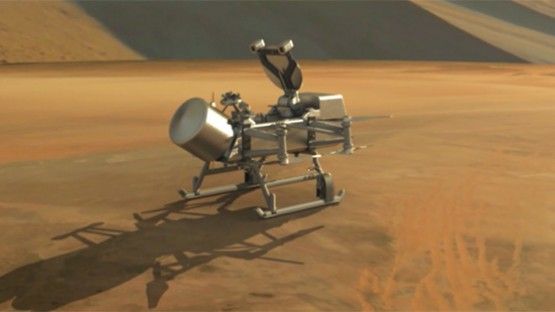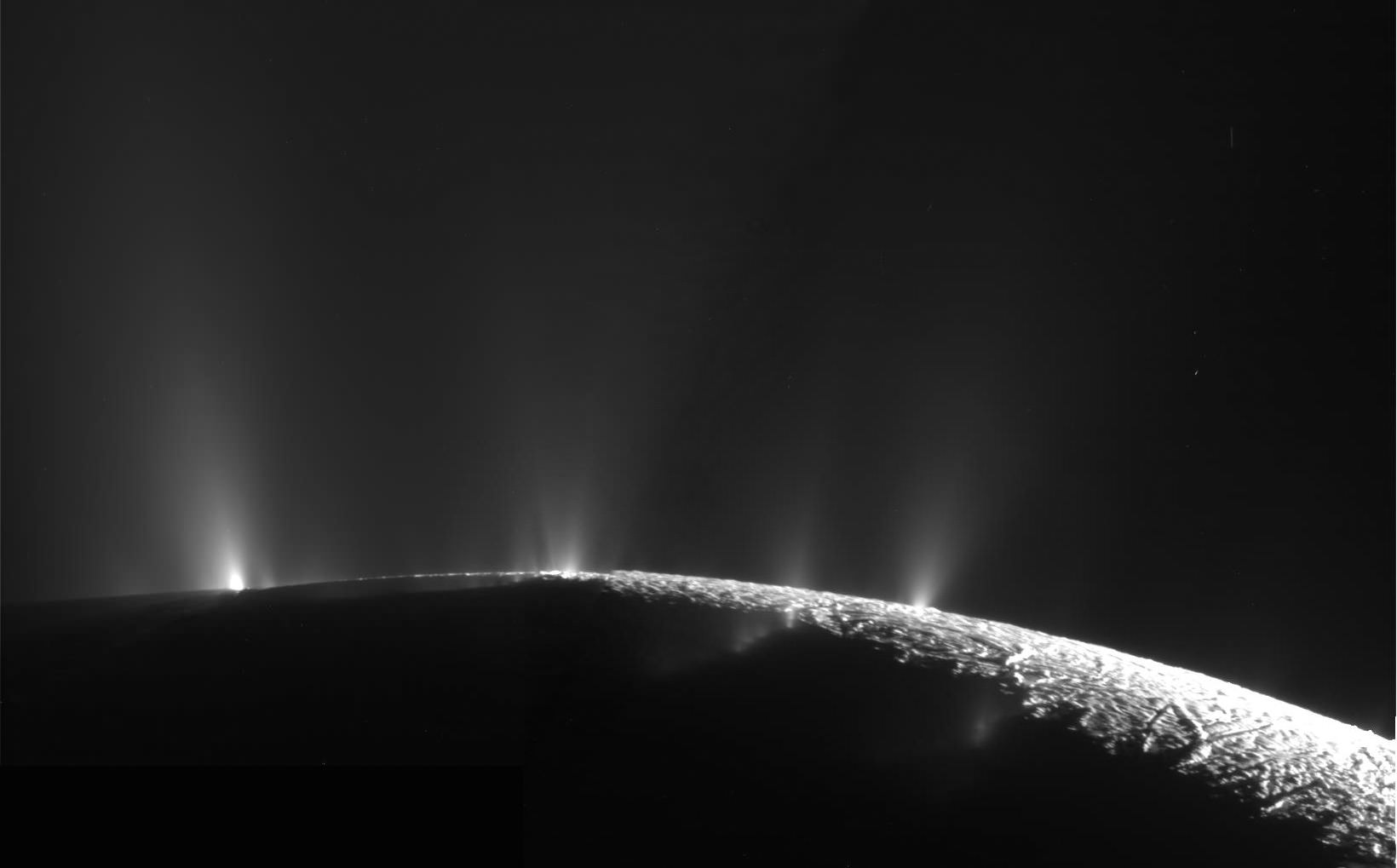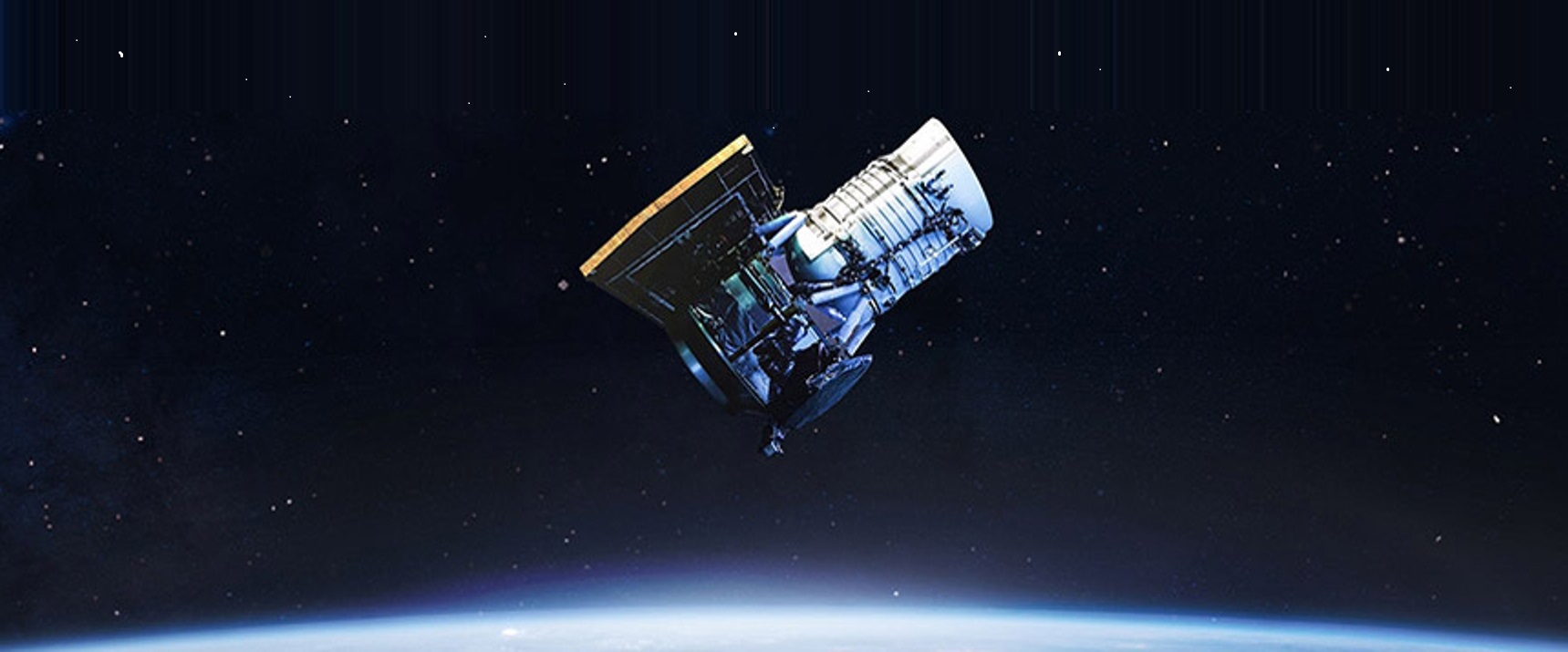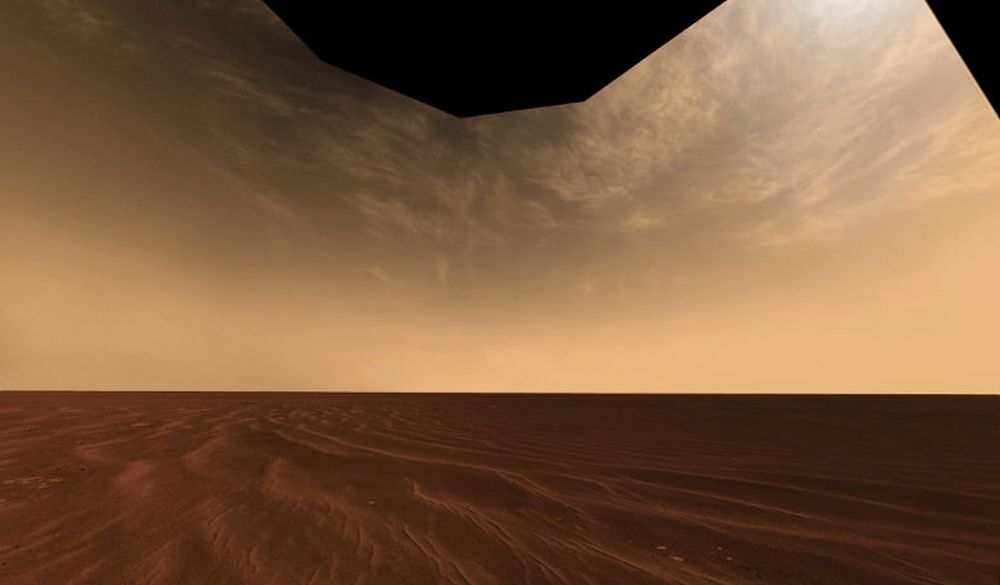Methane is one of the most important greenhouse gases, despite the overwhelming interest in carbon dioxide emissions as the primary source of climate change. It is hard to track, though, as its sources can range from leaking chemical and gas pipelines to literal farm fields. Now an energy analytics company has a system they believe can track otherwise undocumented methane emissions in a way that could prove helpful in eliminating them altogether.
Continue reading “Satellites can now see Exactly Where Methane is Being Dumped Into the Atmosphere”Dragonfly Mission has Some Ambitious Science Goals to Accomplish When it Arrives at Titan
As any good project manager will tell you, goals are necessary to complete any successful project. The more audacious the goal, the more potentially successful the project will be. But bigger goals are harder to hit, leading to an increased chance of failure. So when the team behind one of NASA’s most unique missions released a list of goals this week, the space exploration world took notice. One thing is clear – Dragonfly will not lack ambition.
Continue reading “Dragonfly Mission has Some Ambitious Science Goals to Accomplish When it Arrives at Titan”Cassini Saw Methane in Enceladus’ Plumes. Scientists Don’t Know How it Could be There Without Life
Even though the Cassini mission at Saturn ended nearly four years ago, data from the spacecraft still keeps scientists busy. And the latest research using Cassini’s wealth of data might be the most enticing yet.
Researchers say they’ve detected methane in the plumes of Saturn’s icy moon Enceladus. The process for how the methane is produced is not known at this time, but the study suggests that the surprisingly large amount of methane found are likely coming from activity at hydrothermal vents present on Enceladus’s interior seafloor. These vents could be very similar those found in Earth’s oceans, where microorganisms live, feed on the energy from the vents and produce methane in a process called methanogenesis.
Continue reading “Cassini Saw Methane in Enceladus’ Plumes. Scientists Don’t Know How it Could be There Without Life”With Funding From Jeff Bezos, MethaneSAT Picks Elon Musk’s SpaceX for 2022 Launch
Billionaires Jeff Bezos and Elon Musk are usually rivals on the final frontier, but they both have a role to play in MethaneSAT, a privately backed satellite mission aimed at monitoring methane emissions.
Last November, the Bezos Earth Fund made a $100 million grant to the Environmental Defense Fund to support the satellite’s completion and launch. That grant was part of a $791 million round that Bezos said was “just the beginning of my $10 billion commitment” to address challenges brought on by climate change.
Now MethaneSAT LLC — a subsidiary of Environmental Defense Fund — is announcing that it’s signed a contract with Musk’s SpaceX to send the satellite into orbit on a Falcon 9 rocket by as early as October 2022.
Continue reading “With Funding From Jeff Bezos, MethaneSAT Picks Elon Musk’s SpaceX for 2022 Launch”If a Planet Has a Lot of Methane in its Atmosphere, Life is the Most Likely Cause
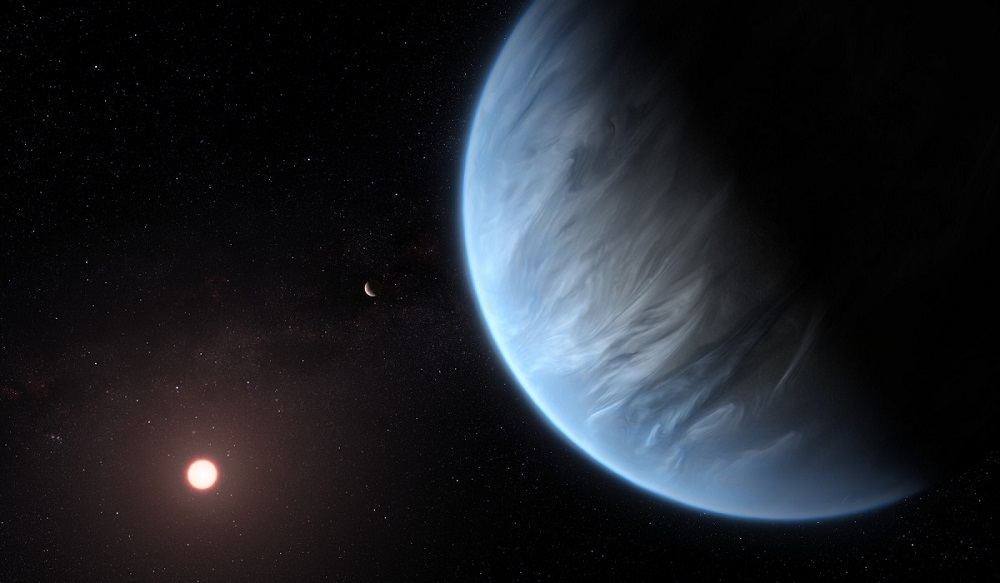
The ultra-powerful James Webb Space Telescope will launch soon. Once it’s deployed, and in position at the Earth-Sun Lagrange Point 2, it’ll begin work. One of its jobs is to examine the atmospheres of exoplanets and look for biosignatures. It should be simple, right? Just scan the atmosphere until you find oxygen, then close your laptop and head to the pub: Fanfare, confetti, Nobel prize.
Of course, Universe Today readers know it’s more complicated than that. Much more complicated.
In fact, the presence of oxygen is not necessarily reliable. It’s methane that can send a stronger signal indicating the presence of life.
Continue reading “If a Planet Has a Lot of Methane in its Atmosphere, Life is the Most Likely Cause”Even If We Cut Greenhouse Gas Emissions Tomorrow, it Would Take Decades for the Earth to Start Cooling Again

If—or hopefully when—we cut our Greenhouse Gas (GHG) emissions, we won’t notice much difference in the climate. The Earth’s natural systems take time to absorb carbon from the atmosphere. We may have to wait decades for the temperatures to drop.
Of course, that doesn’t mean we shouldn’t do it. It’s just that we have to temper our expectations a little.
Continue reading “Even If We Cut Greenhouse Gas Emissions Tomorrow, it Would Take Decades for the Earth to Start Cooling Again”Molecular Oxygen on Mars is Behaving Unusually Through the Seasons. A Sign of Life?
An atmospheric drama has been playing out on Mars lately. Up until now, the main actor has been methane, and its unusual, spiking behaviour. But now Oxygen is taking the stage, and performing some theatrics of its own.
Continue reading “Molecular Oxygen on Mars is Behaving Unusually Through the Seasons. A Sign of Life?”Weekly Space Hangout: Apr 17, 2019 – Dr. Dorothy Oehler Talks “No Methane on Mars?”
Hosts:
Fraser Cain (universetoday.com / @fcain)
Dr. Pamela Gay (astronomycast.com / cosmoquest.org / @starstryder)
Dr. Kimberly Cartier (KimberlyCartier.org / @AstroKimCartier )
Dr. Morgan Rehnberg (MorganRehnberg.com / @MorganRehnberg & ChartYourWorld.org)
Dr. Paul M. Sutter (pmsutter.com / @PaulMattSutter)
Dr. Dorothy Z. Oehler is a planetary geologist and Precambrian paleontologist. Continue reading “Weekly Space Hangout: Apr 17, 2019 – Dr. Dorothy Oehler Talks “No Methane on Mars?””
New Study Provides Explanation for Pluto’s Giant Blades of Ice
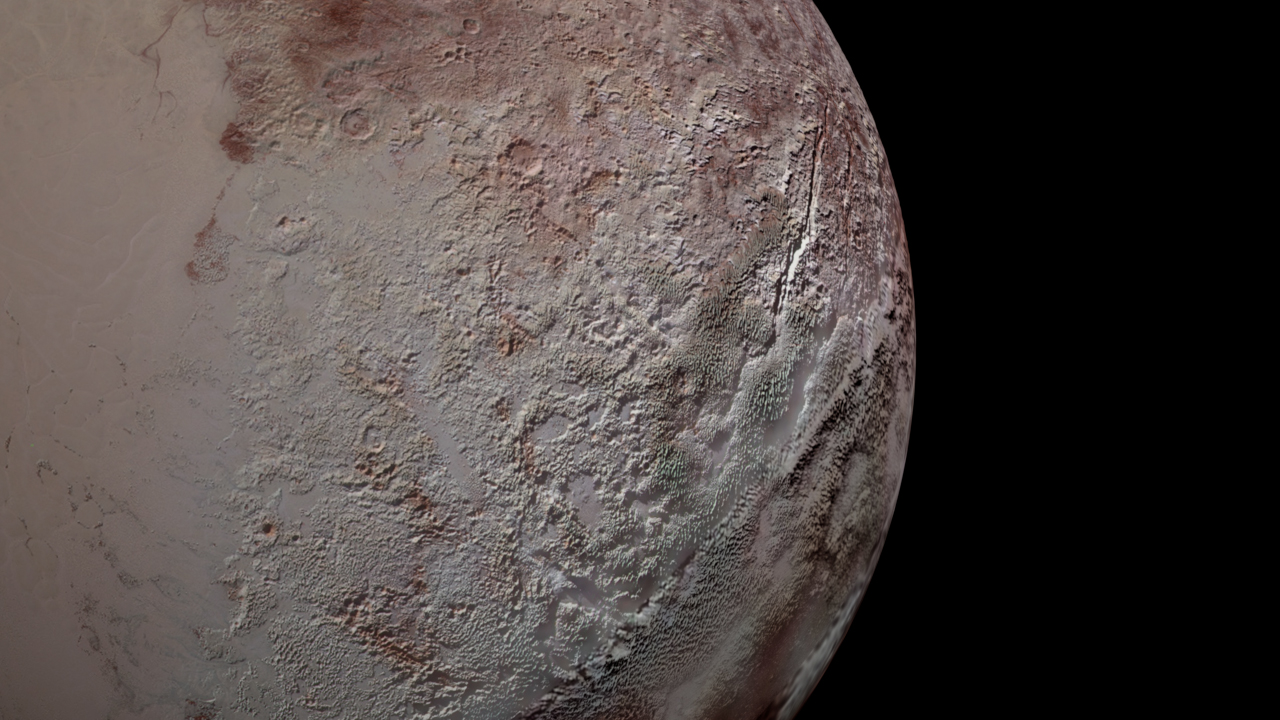
When it made its historic flyby of Pluto in July of 2015, the New Horizons spacecraft gave scientists and the general public the first clear picture of what this distant dwarf planet looks like. In addition to providing breathtaking images of Pluto’s “heart”, its frozen plains, and mountain chains, one of the more interesting features it detected was Pluto’s mysterious “bladed terrain”.
According to data obtained by New Horizons, these features are made almost entirely out of methane ice and resemble giant blades. At the time of their discovery, what caused these features remained unknown. But according to new research by members of the New Horizons team, it is possible that these features are the result of a specific kind of erosion that is related to Pluto’s complex climate and geological history.
Ever since the New Horizons probe provided a detailed look at Pluto’s geological features, the existence of these jagged ridges has been a source of mystery. They are located at the highest altitudes on Pluto’s surface near it’s equator, and can reach several hundred feet in altitude. In that respect, they are similar to penitentes, a type of structure found in high-altitude snowfields along Earth’s equator.
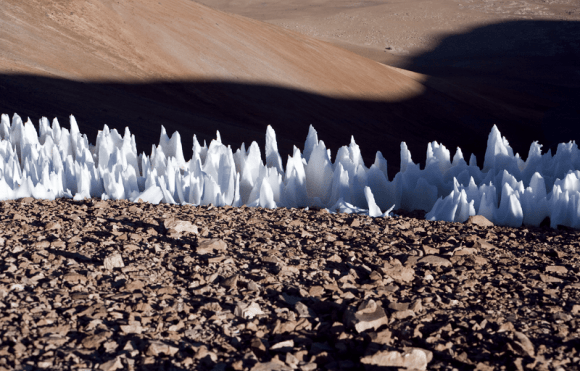
These structures are formed through sublimation, where atmospheric water vapor freezes to form standing, blade-like ice structures. The process is based on sublimation, where rapid changes in temperature cause water to transition from a vapor to a solid (and back again) without changing into a liquid state in between. With this in mind, the research team considered various mechanisms for the formation of these ridges on Pluto.
What they determined was that Pluto’s bladed terrain was the result of atmospheric methane freezing at extreme altitudes on Pluto, which then led to ice structures similar to the ones found on Earth.The team was led by Jeffrey Moore, a research scientist at NASA’s Ames Research Center who was also a New Horizons’ team member. As he explained in a NASA press statement:
“When we realized that bladed terrain consists of tall deposits of methane ice, we asked ourselves why it forms all of these ridges, as opposed to just being big blobs of ice on the ground. It turns out that Pluto undergoes climate variation and sometimes, when Pluto is a little warmer, the methane ice begins to basically ‘evaporate’ away.”
But unlike on Earth, the erosion of these features are related to changes that take place over the course of eons. This should come as no surprise seeing as how Pluto’s orbital period is 248 years (or 90,560 Earth days), meaning it takes this long to complete a single orbit around the Sun. In addition, the eccentric nature of it orbit means that its distance from the Sun ranges considerably, from 29.658 AU at perihelion to 49.305 AU at aphelion.
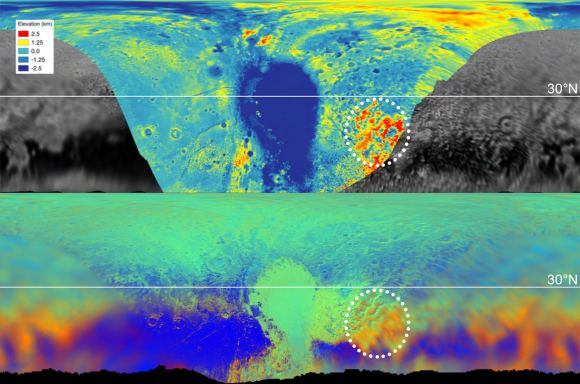
When the planet is farthest from the Sun, methane freezes out of the atmosphere at high altitudes. And as it gets closer to the Sun, these ice features melt and turn directly into atmospheric vapor again. As a result of this discovery, we now know that the surface and air of Pluto are apparently far more dynamic than previously thought. Much in the same way that Earth has a water cycle, Pluto may have a methane cycle.
This discovery could also allow scientists to map out locations of Pluto which were not photographed in high-detail. When the New Horizons mission conducted its flyby, it took high-resolution pictures of only one side of Pluto – designated as the “encounter hemisphere”. However, it was only able to observe the other side at lower resolution, which prevented it from being mapped in detail.
But based on this new study, NASA researchers and their collaborators have been able to conclude that these sharp ridges may be a widespread feature on Pluto’s “far side”. The study is also significant in that it advances our understanding of Pluto’s global geography and topography, both past and present. This is due to the fact that it demonstrated a link between atmospheric methane and high-altitude features. As such, researchers can now infer elevations on Pluto by looking for concentrations of methane in its atmosphere.
Not long ago, Pluto was considered one of the least-understood bodies in our Solar System, thanks to its immense distance from the Sun. However, thanks to ongoing studies made possible by the data collected by the New Horizons mission, scientists are becoming increasingly familiar with what its surface looks like, not to mention the types of geological and climatological forces that have shaped it over time.
And be sure to enjoy this video that details the discovery of Pluto’s bladed terrain, courtesy of NASA’s Ames Research Center:
Further Reading: NASA
What About a Mission to Titan?
As you probably know, NASA recently announced plans to send a mission to Jupiter’s moon Europa. If all goes well, the Europa Clipper will blast off for the world in the 2020s, and orbit the icy moon to discover all its secrets.
And that’s great and all, I like Europa just fine. But you know where I’d really like us to go next? Titan.
Titan, as you probably know, is the largest moon orbiting Saturn. In fact, it’s the second largest moon in the Solar System after Jupiter’s Ganymede. It measures 5,190 kilometers across, almost half the diameter of the Earth. This place is big.
It orbits Saturn every 15 hours and 22 days, and like many large moons in the Solar System, it’s tidally locked to its planet, always showing Saturn one side.
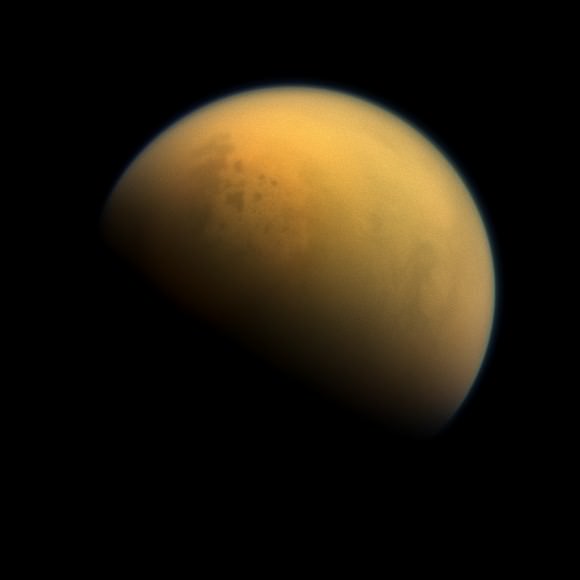
Before NASA’s Voyager spacecraft arrived in 1980, astronomers actually thought that Titan was the biggest moon in the Solar System. But Voyager showed that it actually has a thick atmosphere, that extends well into space, making the true size of the moon hard to judge.
This atmosphere is one of the most interesting features of Titan. In fact, it’s the only moon in the entire Solar System with a significant atmosphere. If you could stand on the surface, you would experience about 1.45 times the atmospheric pressure on Earth. In other words, you wouldn’t need a pressure suit to wander around the surface of Titan.
You would, however, need a coat. Titan is incredibly cold, with an average temperature of almost -180 Celsius. For you Fahrenheit people that’s -292 F. The coldest ground temperature ever measured on Earth is almost -90 C, so way way colder.
You would also need some way to breathe, since Titan’s atmosphere is almost entirely nitrogen, with trace amounts of methane and hydrogen. It’s thick and poisonous, but not murderous, like Venus.
Titan has only been explored a couple of times, and we’ve actually only landed on it once.
The first spacecraft to visit Titan was NASA’s Pioneer 11, which flew past Saturn and its moons in 1979. This flyby was followed by NASA’s Voyager 1 in 1980 and then Voyager 2 in 1981. Voyager 1 was given a special trajectory that would take it as close as possible to Titan to give us a close up view of the world.

Voyager was able to measure its atmosphere, and helped scientists calculate Titan’s size and mass. It also got a hint of darker regions which would later turn out to be oceans of liquid hydrocarbons.
The true age of Titan exploration began with NASA’s Cassini spacecraft, which arrived at Saturn on July 4, 2004. Cassini made its first flyby of Titan on October 26, 2004, getting to within 1,200 kilometers or 750 miles of the planet. But this was just the beginning. By the end of its mission later this year, Cassini will have made 125 flybys of Titan, mapping the world in incredible detail.
Cassini saw that Titan actually has a very complicated hydrological system, but instead of liquid water, it has weather of hydrocarbons. The skies are dotted with methane clouds, which can rain and fill oceans of nearly pure methane.
And we know all about this because of Cassini’s Huygen’s lander, which detached from the spacecraft and landed on the surface of Titan on January 14, 2005. Here’s an amazing timelapse that shows the view from Huygens as it passed down through the atmosphere of Titan, and landed on its surface.
Huygens landed on a flat plain, surrounded by “rocks”, frozen globules of water ice. This was lucky, but the probe was also built to float if it happened to land on liquid instead.
It lasted for about 90 minutes on the surface of Titan, sending data back to Earth before it went dark, wrapping up the most distant landing humanity has ever accomplished in the Solar System.
Although we know quite a bit about Titan, there are still so many mysteries. The first big one is the cycle of liquid. Across Titan there are these vast oceans of liquid methane, which evaporate to create methane clouds. These rain, creating mists and even rivers.
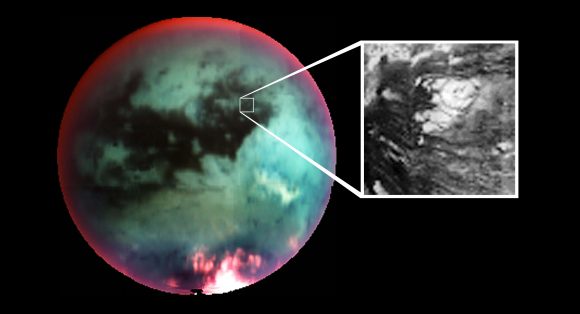
Is it volcanic? There are regions of Titan that definitely look like there have been volcanoes recently. Maybe they’re cryovolcanoes, where the tidal interactions with Saturn cause water to well up from beneath crust and erupt onto the surface.
Is there life there? This is perhaps the most intriguing possibility of all. The methane rich system has the precursor chemicals that life on Earth probably used to get started billions of years ago. There’s probably heated regions beneath the surface and liquid water which could sustain life. But there could also be life as we don’t understand it, using methane and ammonia as a solvent instead of water.
To get a better answer to these questions, we’ve got to return to Titan. We’ve got to land, rove around, sail the oceans and swim beneath their waves.
Now you know all about this history of the exploration of Titan. It’s time to look at serious ideas for returning to Titan and exploring it again, especially its oceans.
Planetary scientists have been excited about the exploration of Titan for a while now, and a few preliminary proposals have been suggested, to study the moon from the air, the land, and the seas.
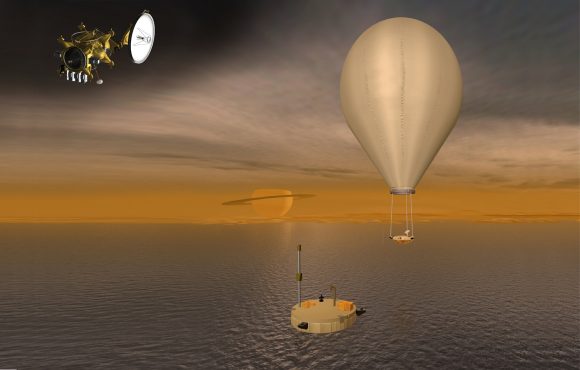
First up, there’s the Titan Saturn System Mission, a mission proposed in 2009, for a late 2020s arrival at Titan. This spacecraft would consist of a lander and a balloon that would float about in the atmosphere, and study the world from above. Over the course of its mission, the balloon would circumnavigate Titan once from an altitude of 10km, taking incredibly high resolution images. The lander would touch down in one of Titan’s oceans and float about on top of the liquid methane, sampling its chemicals.
As we stand right now, this mission is in the preliminary stages, and may never launch.
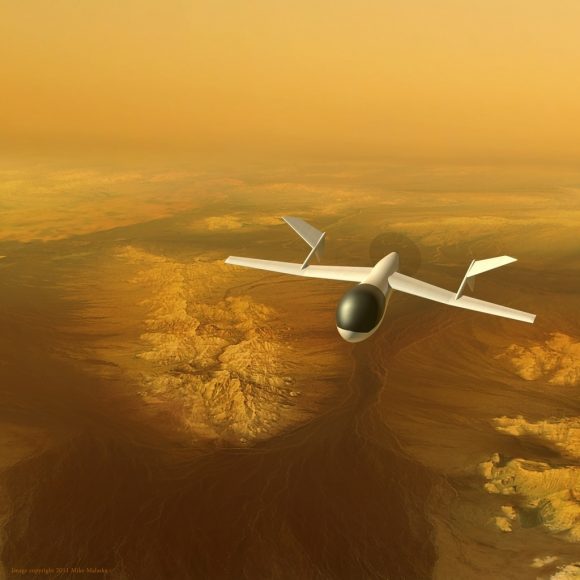
In 2012, Dr. Jason Barnes and his team from the University of Idaho proposed sending a robotic aircraft to Titan, which would fly around in the atmosphere photographing its surface. Titan is actually one of the best places in the entire Solar System to fly an airplane. It has a thicker atmosphere and lower gravity, and unlike the balloon concept, an airplane is free to go wherever it needs powered by a radioactive thermal generator.
Although the mission would only cost about $750 million or so, NASA hasn’t pushed it beyond the conceptual stage yet.
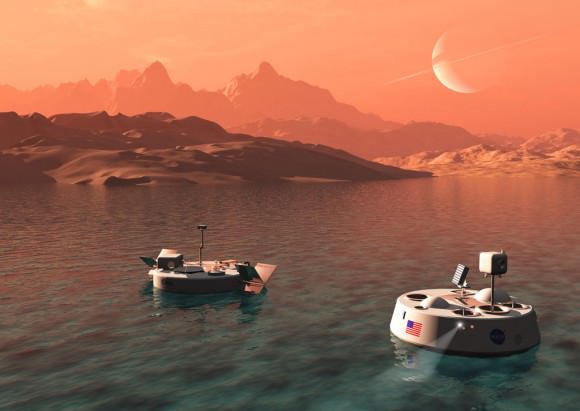
An even cooler plan would put a boat down in one of Titan’s oceans. In 2012, a team of Spanish engineers presented their idea for how a Titan boat would work, using propellers to put-put about across Titan’s seas. They called their mission the Titan Lake In-Situ Sampling Propelled Explorer, or TALISE.
Propellers are fine, but it turns out you could even have a sailboat on Titan. The methane seas have much less density and viscosity than water, which means that you’d only experience about 26% the friction of Earth. Cassini measured windspeeds of about 3.3 m/s across Titan, which half the average windspeed of Earth. But this would be plenty of wind to power a sail when you consider Titan’s thicker atmosphere.
And here’s my favorite idea. A submarine. This 6-meter vessel would float on Titan’s Kraken Mare sea, studying the chemistry of the oceans, measuring currents and tides, and mapping out the sea floor.
It would be capable of diving down beneath the waves for periods, studying interesting regions up close, and then returning to the surface to communicate its findings back to Earth. This mission is in the conceptual stage right now, but it was recently chosen by NASA’s Innovative Advanced Concepts Group for further study. If all goes well, the submarine would travel to Titan by 2038 when there’s a good planetary alignment.
Okay? Are you convinced? Let’s go back to Titan. Let’s explore it from the air, crawl around on the surface and dive beneath its waves. It’s one of the most interesting places in the entire Solar System, and we’ve only scratched the surface.
If I’ve done my job right, you’re as excited about a mission to Titan as I am. Let’s go back, let’s sail and submarine around that place. Let me know your thoughts in the comments.


